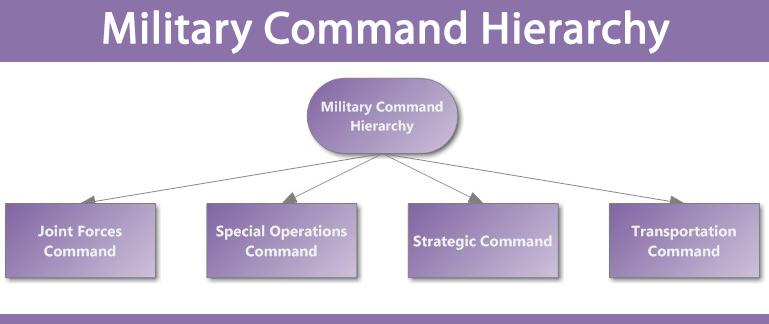A command is generally referred to as an organizational unit which comprises of the military personnel. A command takes the responsibility of planning and using the available resources in an effective way and to coordinate and direct the military forces in achieving the assigned missions successfully. A command also takes into account, the responsibility of the health and welfare of the military personnel. The way in which all the commands in the entire army are connected to each other is known as military command hierarchy.

Each and every military organization has a typical chain of command through which all the official orders and essential procedures flow. The military organization is generally divided into four functional commands such as
- Joint Forces Command
- Special Operations Command
- Strategic Command
- Transportation Command
Now coming to the basic chain of command that is prevalent in the military organization, is as follows:
The basic building blocks of all the military organizations are the individual soldiers. So, the chain of command in the ascending order starts from the soldiers. The soldiers are the basic organizational structure of the army. The order then as per military command hierarchy, flows in this way:
- Squad: A Squad consists of nine to ten soldiers. The size of a squad is dependent on the function or the mission, in which they are engaged or are going to be engaged. A squad is commanded by a sergeant or a staff sergeant. The Squad is the smallest section in the military hierarchy structure.
- Platoon: A platoon generally consists of sixteen to forty soldiers. They are led by a lieutenant. A platoon generally consists of two or four squads.
- Company: A company generally comprises of sixty to two hundred soldiers. It can otherwise be said that, a company is composed of three to five platoons. A company is commanded by a captain. A first sergeant acts as the principal assistant of the captain.
- Battalion: A battalion is a comparatively larger group, consisting of three hundred to one thousand soldiers. A battalion is headed by a lieutenant colonel. A major sergeant acts as the principal assistant of the captain of the battalion. A battalion can be said as the collection of four to five companies. A battalion has the privilege to perform independent operations.
- Brigade: A brigade is an even larger group, consisting of three thousand to five thousand soldiers approximately. The brigades are normally employed on independent or semi-independent operations. They are headed by a colonel with a major sergeant as the principal assistant.
- Division: A division consists of approximately ten thousand to fifteen thousand soldiers. They can be assumed to comprise of approximately three to four brigades. The divisions are commanded by a major general and are assigned duties according to the structures.
- Corps: Five to six divisions comprise to form a corp. The corps is headed by a lieutenant general. The corps groups are engaged in performing the multinational operations.
- Army: The army is the largest unit of the military line of command. It generally consists of soldiers, numbered above fifty thousand. The army is headed by a commander in chief. An army group may also comprise of two or more field armies under a single commanding officer.
The sizes as discussed, of the various command elements do not remain constant. They vary from time to time, according to the type of mission to be accomplished. Different missions have different requirements and therefore the military command elements may also undergo certain change depending on that.
